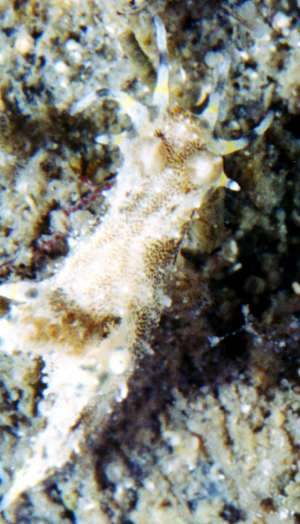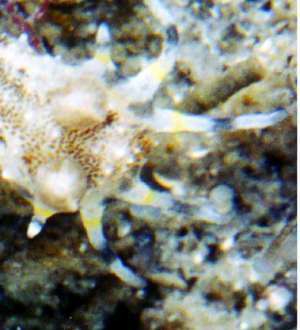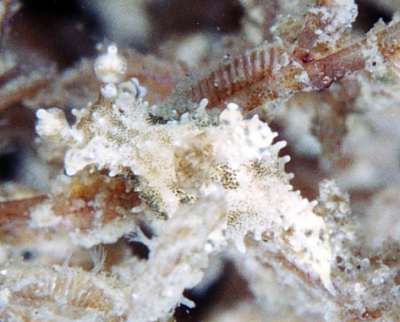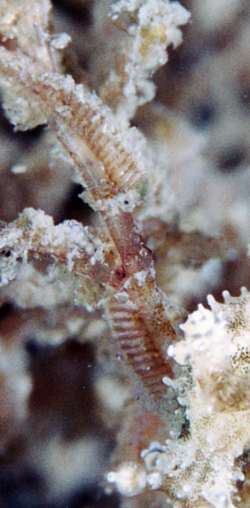

Polycera aurisula
Marcus, 1957
Order: NUDIBRANCHIA
Suborder: DORIDINA
Superfamily: ANADORIDOIDEA
Family: Polyceridae
DISTRIBUTION
West Atlantic [Brazil - Florida]
PHOTO
Lake Worth Lagoon, Southeast coast of Florida, USA. Depth: 15 feet. February 1, 2004. approx 8mm long. Photo: Linda Ianiello.
This species was originally described from 6 small specimens [largest 6mm long] from Brazi (Marcus,1957) The body colour was described as being: "soft brown mottled all over. The velar processes have an orange base, a blue middle zone and a light blue tip. The extrabranchial appendages have a blue ring in the middle followed by an yellowish orange one and a light tip. A triangular spot of blue and orange, though paler, appears on the tail".
Marcus describes them as having 4, [in the biggest slug 6] slender digitiform pointed velar processes. The three extra-branchial processes on each side of the gills are described as 'thick carrot-shaped' and they increase in length from the front to the back. Marcus compares P. aurisula with the similarly coloured Polycera hummi and notes the following points of difference. The extrabranchial processes differ in shape and the much larger P. hummi never has more than 4 velar processes while P. aurisula can have 4-6. The radula differs with the innermost lateral tooth in P. hummi having 5 denticles while in P. aurisula that tooth has a spur, but no denticles.
In the following year {Marcus, 1958) describes further Brazilian specimens, but these are slightly larger, (up to 10mm long), an lack the yellow and blue pigmentation, causing Marcus to suggest that they lose this colour as they grow. Specimens have also been reported from Florida (Marcus & Marcus, 1960) but no information was given on their living size and colour.
Although both P. hummi and P. aurisula have a brown speckled background colour and can have blue and yellow banding on the velar and extrabranchial processes they can be distinguished from one another on a number of characters. Firstly P. hummi can grow to at least 20mm in length while the largest specimens of P. aurisula have been no more than 10mm. In P. hummi the blue and yellow bands are close together and there is a central yellow band flanked on each side by a blue band. In P. aurisula there is usually a basal, or lower yellow (or orange) band, then a median dark blue band, and a light blue tip to the process. In P. aurisula the three bands can be close together, in smaller processes, or widely separated, in larger processes. P. hummi never has more than 2 velar processes on each side while P. aurisula can have up to 4. In P. hummi the 3-4 extrabranchial processes on each side of the gills are blunt and club shaped, and contracted into a thin 'stalk' at the base. In P. aurisula by comparison, the 2-3 extrabranchial processes on each side are 'carrot-shaped', pointed at the tip and broad at the base.
References:
• Marcus, Er. (1957) On Opisthobranchia from Brazil (2). Journal of the Linnean Society of London, Zoology, 43(292): 390-486.
• Marcus, Er (1958) Notes on Opisthobranchia. Bol. Inst. Oceanogr. Univ. Sao Paulo, 7(1-2): 31-78,Pls.1-8.
• Marcus, Ev. & Marcus, Er (1960) Opisthobranchs from American Atlantic warm waters. Bull. Mar. Sci., 10: 129-203.
Rudman, W.B., 2004 (February 10) Polycera aurisula Marcus, 1957. [In] Sea Slug Forum. Australian Museum, Sydney. Available from http://www.seaslugforum.net/find/polyauri
Related messages
Polycera aurisula from Florida
February 13, 2004
From: Bill Rudman
I have been uncomfortable with the identification of the Polycera in Linda Ianiello's recent message [#12126] as P. hummi. Although they both have blue and yellow bands on the the velar and extra-branchial processes, they are arranged in a different order. After a search through the literature I am pretty sure this animal is Polycera aurisula.
Although both P. hummi and P. aurisula have a brown speckled background colour and can have blue and yellow banding on the velar and extrabranchial processes they can be distinguished from one another on a number of characters. Firstly P. hummi can grow to at least 20mm in length while the largest specimens of P. aurisula have been no more than 10mm. In P. hummi the blue and yellow bands are close together and there is a central yellow band flanked on each side by a blue band. In P. aurisula there is usually a basal, or lower yellow (or orange) band, then a median dark blue band, and a light blue tip to the process. In P. aurisula the three bands can be close together, in smaller processes, or widely separated, in larger processes. P. hummi never has more than 2 velar processes on each side while P. aurisula can have up to 4. In P. hummi the 3-4 extrabranchial processes on each side of the gills are blunt and club shaped, and contracted into a thin 'stalk' at the base. In P. aurisula by comparison, the 2-3 extrabranchial processes on each side are 'carrot-shaped', pointed at the tip and broad at the base.
Although this is not a new record for Florida, I think it is the first time we have a colour photo of it publicly available
References:
• Marcus, Er. (1957) On Opisthobranchia from Brazil (2). Journal of the Linnean Society of London, Zoology, 43(292): 390-486.
• Marcus, Er (1958) Notes on Opisthobranchia. Bol. Inst. Oceanogr. Univ. Sao Paulo, 7(1-2): 31-78,Pls.1-8.
• Marcus, Ev. & Marcus, Er (1960) Opisthobranchs from American Atlantic warm waters. Bull. Mar. Sci., 10: 129-203.
Best wishes,
Bill Rudman
Another record of Polycera hummi from Florida
February 5, 2004
From: Linda Ianniello

Following your recent comments I went out looking for another Okenia evelinae to try and get a better shot. By chance, I found this slug, which is about the same size - maybe 8mm and too small to see distinguishing features very well underwater - on the same bryozoan with an Okenia evelinae. When I got the film processed, I realized I had two different slugs. Once again, the animal is so small the shots are not very good, but this head shot is reasonably focused. The second shot shows the growth it was found on, and a bit better shot of the rhinophores. I think it might be Polycera hummi? Though it is a lot smaller than the other one on the Forum ...
Location: Lake Worth Lagoon, Southeast coast of Florida, USA. Depth: 15 feet. February 1, 2004
Thanks for your help with another identification!
Regards,
Linda I.
lindai@us.ibm.com



NOTE added 13 Feb 2004: This is
Dear Linda,
Your messages always come up with little surprises. I agree that this is almost certainly a juvenile of P. hummi. I suspect the distance between the blue and yellow banding, and the absence of the inner blue band is because the animal is so small, but I guess it will be worth checking on if you come across the species again.
Then most interesting thing in your message is the bryozoan. I am not an expert on bryozoans but I am pretty sure this is Amathia distans Busk, 1886, which has a circumtropical distribution and is a common in the western Atlantic. It is found from North Carolina to Brazil. The way the zooids are arrange in slightly curved double rows is typical of the species. There is an illustration on the Smithsonian Marine Station at Fort Pierce website at
www.sms.si.edu/irlspec/Amathi_distan.htm
You may remember in my discussion of Okenia evelinae that I noted that Marcus reported it feeding on Amathia convoluta. My understanding is that true A. convoluta is a South Pacific species so it is quite possible that Marcus's record is a misidentification for Amathia distans. Your bryozoan is quite different from Zoobotryon which has almost transparent stalks and irregularly arranged zooids. The exciting thing is that you found a specimen of the animal I have identified as Okenia evelinae on this bryozoan, which certainly adds weight to my suggestion that it is distinct from Okenia zoobotryon which has only been reported from the bryozoan Zoobotryon.
Best wishes
Bill Rudman
